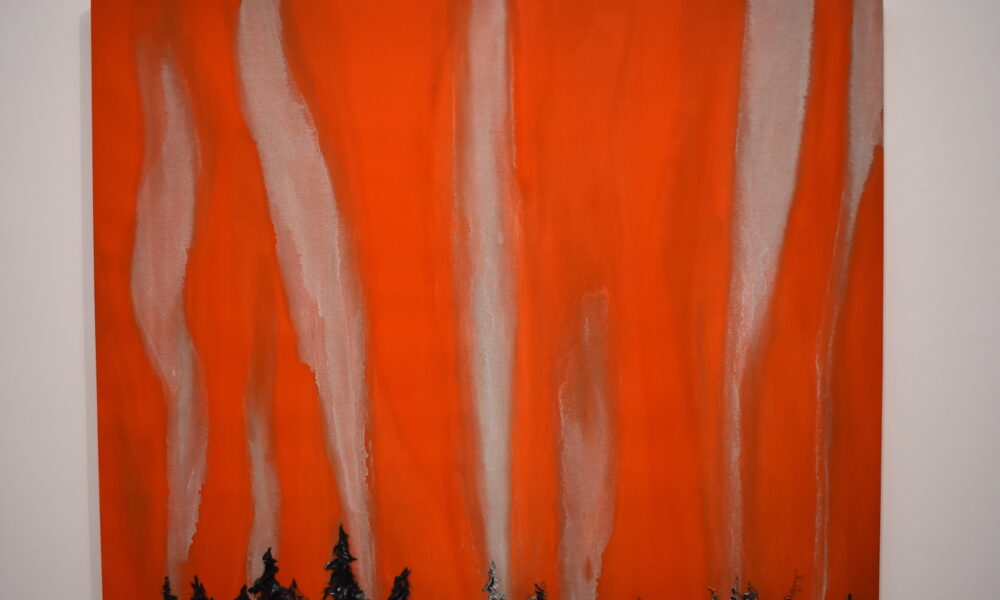Landscapes, Colour and a Portrait is a one-room exhibit currently hosted by Bradley Ertaskiran, a gallery nestled in the Saint-Henri area. Featuring pieces painted by Toronto-based Canadian artist Kim Dorland, the exhibit portrays 13 forests and a single portrait. As traditional depictions of winter landscapes are often seas of grays, the brightly coloured oil paintings of foliage and sky are an especially compelling collection.
Dorland employs three-dimensional aspects of visual art to create a diverse array of texture-based effects, which add dimensionality—literally—to the viewing experience. Many of the artworks invite viewers into a dense, deep forest. For instance, his large painting Black depicts a forest in monochrome black, with brush strokes creating tree-like shapes amongst what is otherwise a homogeneous canvas. Additional techniques are featured in Orange and Pink, which has globs of thick paint that curl downwards to resemble shrubbery. In The Fence, the paint is a translucent wash which reveals the canvas underneath.
Contrasting colours are also a focal point of Dorland’s work. In Pink and White, for instance, a neon pink background affronts the eyes, and the whiteness of the trees contrasts with a psychedelic sky behind it. The landscapes aren’t realistic, nor can they be tied to specific locations, but they nevertheless possess an air of nostalgia for a viewer familiar with the Canadian winterscape. The depth of paint strokes, as well as their wild direction, is reminiscent of thick foliage. The absolute white emerging from harsh colour is similar to the blinding reflectivity of freshly fallen snow.
Viewers can then turn their attention to the uneasiness present in many paintings, which surfaces through the tangles of brushstrokes and unnatural neons. As written in the exhibit description, Dorland’s landscape follows the stakes of the climate emergency from vague concern to approaching palpable reality. In light of this helpful interpretive guide, one can see an undercurrent of climate crisis-related panic running through many of Dorland’s pieces. A particularly striking example is Smoke, which depicts the sky above a burning forest. At the bottom of the painting, the top of a black treeline lies beneath a red sky with trails of white smoke. Rather than drawing the viewer’s eyes to the forest below, the smoke situates the viewer’s perspective into the atmosphere, where the smoke from forest fires, which are ironically also often exacerbated by climate change, further contribute to the greenhouse effect. In Smoke, Dorland makes subtle, but poignant, social commentary: Just as a fire rages beyond the painting’s frame, the forces propelling climate change, such as the emission of greenhouse gases and building of pipelines, are invisible to many.
The final photo, if viewers circle the room, is a portrait of a girl called Lori. She is bisected by different colours, and her face is demolished with thick paint smears. The brushstrokes leave traces of the canvas underneath, and there is a troubling sense of incompleteness as the featureless face confronts viewers at eye level.
The masses of oil pants Dorland works with artfully impress depth and chaos to the forests and Lori. The journey from deep pink to pure black to olive green is a reflection of the turbulence witnessed in the environment today. The more time spent in Landscapes, Colour and a Portrait, the more the paintings reveal themselves to be a dreamlike meditation on the tensions of our relationship with the outside world. It is a thought-provoking and moving experience.
The art gallery is free and open to the public without reservation and can be visited during 11 a.m. to 6 p.m. Wednesday through Friday, and 12 p.m. to 5 p.m. on Saturdays, until Feb. 26.








